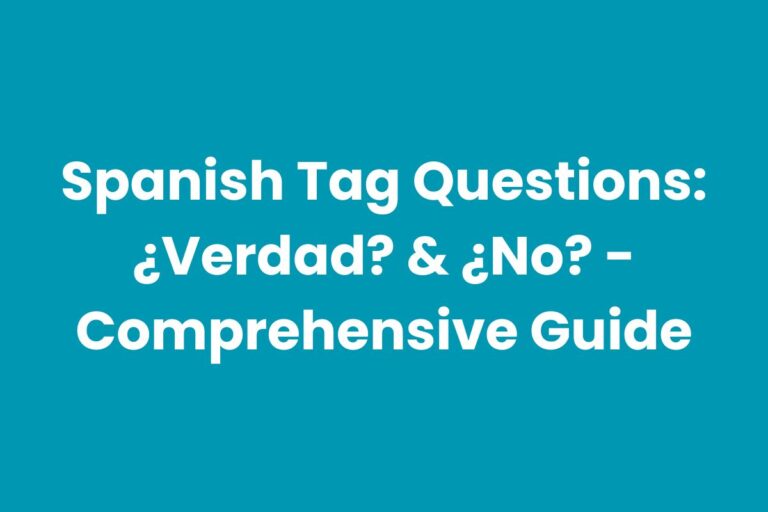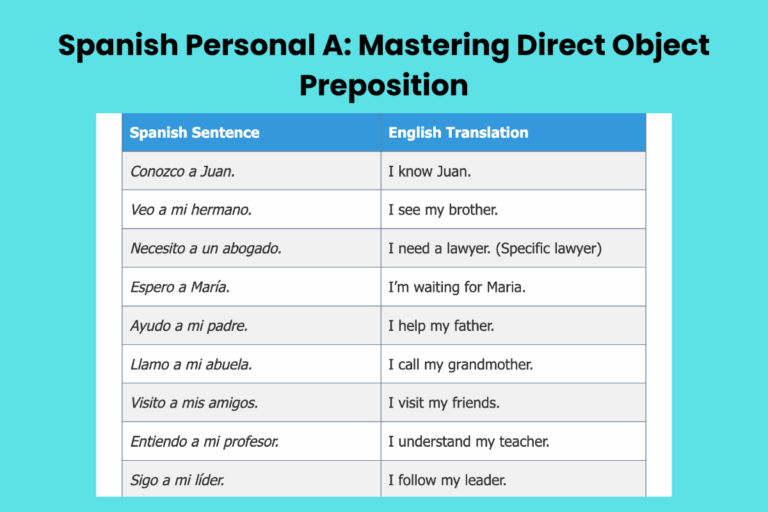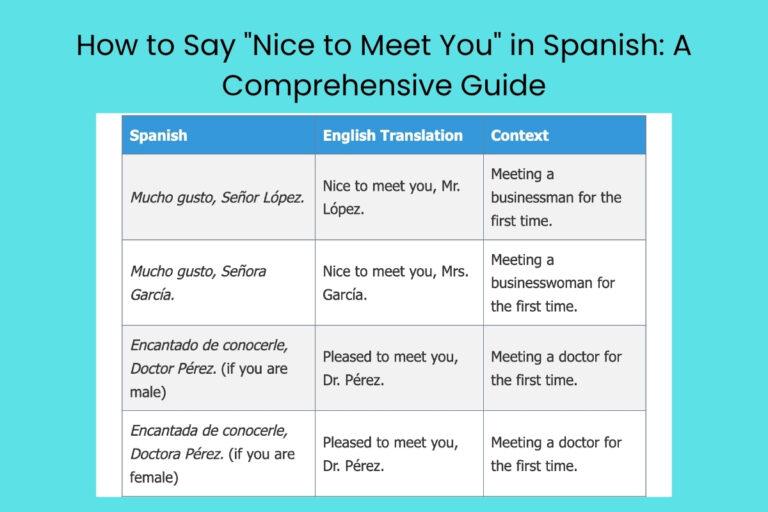Spanish Diminutives: Mastering -ito, -ita Endings
Understanding Spanish diminutives, particularly the endings -ito and -ita, is crucial for achieving fluency and appreciating the nuances of the language. These suffixes aren’t just about making words smaller; they convey affection, endearment, or even irony. Mastering diminutives allows you to express emotions and subtle meanings that would otherwise be lost in translation. This article will benefit students of all levels, from beginners seeking to expand their vocabulary to advanced learners aiming to refine their expressive abilities in Spanish.
Table of Contents
- Definition of Spanish Diminutives
- Structural Breakdown of Diminutives
- Types and Categories of Diminutives
- Examples of Diminutives
- Usage Rules for Diminutives
- Common Mistakes with Diminutives
- Practice Exercises
- Advanced Topics on Diminutives
- Frequently Asked Questions
- Conclusion
Definition of Spanish Diminutives
A diminutive is a suffix added to a word, typically a noun or adjective, to indicate smallness, endearment, or a lessened degree of the quality described. In Spanish, the most common diminutive suffixes are -ito and -ita, which correspond to masculine and feminine nouns, respectively. These suffixes go beyond simply indicating size; they often imbue the word with a sense of affection, familiarity, or even irony, depending on the context.
Diminutives are a type of derivational morphology, meaning they create a new word with a slightly different meaning from the original. The use of diminutives is highly prevalent in everyday Spanish conversation, adding color and emotional depth to communication.
Understanding and using diminutives correctly is essential for comprehending the subtle nuances of the language and interacting naturally with native speakers. The function of diminutives extends beyond mere reduction in size; it’s a powerful tool for expressing emotions and attitudes.
Structural Breakdown of Diminutives
The basic structure of forming a diminutive involves adding the suffix -ito or -ita to the end of a noun or adjective. However, the process isn’t always straightforward. Several rules govern how the suffix is attached, depending on the word’s ending and pronunciation. These rules ensure that the resulting word is grammatically correct and sounds natural.
For words ending in a vowel, the vowel is typically dropped before adding the suffix. For example, casa (house) becomes casita (small house). Words ending in consonants often require an insertion of a connecting vowel, which is usually -e-, to ease pronunciation. This insertion is particularly common with words ending in -n, -r, or -e. Understanding these structural adjustments is key to forming diminutives correctly and confidently. Let’s explore these structural breakdowns in more detail.
Vowel Dropping
When a noun or adjective ends in a vowel, that vowel is generally removed before adding the diminutive suffix. This rule simplifies pronunciation and maintains the flow of the word.
For example:
- Mesa (table) → Mesita (small table)
- Niño (boy) → Niñito (small boy)
- Abuela (grandmother) → Abuelita (grandma)
Consonant Insertion
For words ending in consonants, inserting a connecting vowel (usually -e-) before adding the diminutive suffix is common. This helps to avoid awkward pronunciations. Consider the following examples:
- Pan (bread) → Panecito (small bread/roll)
- Flor (flower) → Florecita (small flower)
- Amor (love) → Amorcito (dear/sweetheart)
Special Cases
Some words require more significant changes to maintain their pronunciation or meaning when forming diminutives. These often involve changes in spelling or the addition of different diminutive suffixes.
Here are a few examples:
- Poco (little) → Poquito (a little bit)
- Agua (water) → Agüita (a little water) – note the addition of the dieresis.
- Ahora (now) → Ahorita (right now/soon)
Types and Categories of Diminutives
Diminutives in Spanish can be categorized based on their function and the degree of intensity they convey. While the primary function is to indicate smallness, they can also express affection, endearment, irony, or even contempt.
Understanding these different nuances is essential for using diminutives appropriately and interpreting their meaning correctly.
One way to categorize diminutives is by the emotion or attitude they express. Affectionate diminutives are used to show love or fondness, while ironic diminutives are used to convey sarcasm or mockery.
Another way to categorize them is by the degree of intensity, ranging from simple smallness to extreme endearment. Recognizing these categories will help you understand the context in which a diminutive is used and the speaker’s intended meaning.
The emotional context dramatically changes the interpretation of the diminutive.
Affectionate Diminutives
These diminutives express love, fondness, or tenderness. They are often used when speaking to children, loved ones, or close friends.
Examples include:
- Cariño (affection) → Cariñito (dear/sweetheart)
- Mami (mommy) → Mamita (mommy dear)
- Papi (daddy) → Papito (daddy dear)
Ironic Diminutives
Ironic diminutives are used to convey sarcasm, mockery, or a sense of belittlement. The meaning is often the opposite of affection or endearment.
For example:
- Grande (big) → Grandecito ( sarcastically “big”) – used when something is not big at all.
- Listo (clever) → Listillo (smart aleck)
Diminutives of Size
These diminutives simply indicate a smaller size compared to the original object or concept. They don’t necessarily carry any emotional connotation.
Examples include:
- Casa (house) → Casita (small house)
- Libro (book) → Librito (small book)
- Coche (car) → Cochecito (small car)
Examples of Diminutives
To fully grasp the usage of diminutives, let’s explore a comprehensive set of examples. These examples are categorized to illustrate the different contexts and nuances of diminutive usage.
Understanding these contexts will enable you to use diminutives effectively and interpret their meaning accurately. The following tables provide a rich collection of examples.
Table 1: Common Noun Diminutives
This table showcases how diminutives are formed from common nouns, illustrating the basic rules of vowel dropping and consonant insertion. These examples provide a foundation for understanding the structural mechanics of diminutive formation.
Notice the subtle shifts in meaning and emotional tone.
| Original Noun | Diminutive Form | English Translation |
|---|---|---|
| Casa | Casita | Small house |
| Perro | Perrito | Small dog/Puppy |
| Gato | Gatito | Small cat/Kitten |
| Libro | Librito | Small book |
| Mesa | Mesita | Small table |
| Silla | Sillita | Small chair |
| Coche | Cochecito | Small car |
| Árbol | Arbolito | Small tree |
| Flor | Florecita | Small flower |
| Sol | Solecito | Little sun |
| Luna | Lunita | Little moon |
| Viento | Vientito | Little wind |
| Agua | Agüita | Little water |
| Café | Cafecito | Small coffee |
| Pan | Panecito | Small bread/Roll |
| Vino | Vinito | Small wine |
| Cama | Camita | Small bed |
| Plato | Platito | Small plate |
| Vaso | Vasito | Small glass |
| Jardín | Jardincito | Small garden |
| Papel | Papelito | Small piece of paper |
| Ciudad | Ciudadcita | Small city |
| Pueblo | Pueblito | Small town |
| Río | Ríito | Small river |
| Montaña | Montañita | Small mountain |
Table 2: Adjective Diminutives Expressing Degree
This table illustrates how adjectives are transformed into diminutives to express a reduced degree of the quality they describe. These examples highlight the subtle ways in which diminutives can soften or lessen the impact of an adjective.
Notice how the diminutive form creates a milder or more delicate connotation.
| Original Adjective | Diminutive Form | English Translation |
|---|---|---|
| Pequeño | Pequeñito | Very Small/Tiny |
| Bonito | Bonito | Pretty |
| Feo | Feíto | A little ugly |
| Caliente | Calentito | Warm |
| Frío | Fríito | Chilly |
| Dulce | Dulcito | Slightly sweet |
| Suave | Suavecito | Soft |
| Lento | Lentito | Slowly |
| Rápido | Rapidito | Quickly |
| Cerca | Cerquita | Very close |
| Lejos | Lejitos | Far away |
| Nuevo | Nuevecito | Brand new |
| Viejo | Viejito | Old |
| Caro | Carito | Expensive (but not too much) |
| Barato | Baratito | Cheap (slightly) |
| Fácil | Facilito | Easy |
| Difícil | Dificilito | A little difficult |
| Bueno | Buenito | Good (slightly) |
| Malo | Malito | Sick (slightly) |
| Alto | Alito | Kind of tall |
| Bajo | Bajito | Kind of short |
| Ancho | Anchito | Kind of wide |
| Estrecho | Estrechito | Kind of narrow |
| Largo | Larguito | Kind of long |
| Corto | Cortito | Kind of short |
Table 3: Diminutives Expressing Affection
This table showcases diminutives used to express affection, endearment, or tenderness. These examples demonstrate how diminutives can transform a simple word into a term of love and care.
Notice the emotional warmth and closeness conveyed by these diminutive forms.
| Original Word | Diminutive Form | English Translation |
|---|---|---|
| Amor | Amorcito | My love/Sweetheart |
| Cariño | Cariñito | Dear/Sweetheart |
| Corazón | Corazoncito | Little heart/Sweetheart |
| Mami | Mamita | Mommy dear |
| Papi | Papito | Daddy dear |
| Abuela | Abuelita | Grandma |
| Abuelo | Abuelito | Grandpa |
| Hermano | Hermanito | Little brother |
| Hermana | Hermanita | Little sister |
| Hijo | Hijito | Sonny |
| Hija | Hijita | Daughter |
| Amigo | Amiguito | Little friend |
| Amiga | Amiguita | Little friend (female) |
| Bebé | Bebecito | Little baby |
| Niño | Niñito | Little boy |
| Niña | Niñita | Little girl |
| Mi Vida | Vidita | My little life |
| Cielo | Cielito | Little heaven |
| Alma | Almita | Little soul |
| Tesoro | Tesorito | Little treasure |
| Sol | Solecito | My little sun |
| Luz | Lucita | My little light |
| Reina | Reinita | Little queen |
| Rey | Reycito | Little king |
Table 4: Diminutives with Irregular Forms
This table includes examples of diminutives that have irregular forms, often due to phonetic or historical reasons. These examples highlight the exceptions to the standard rules of diminutive formation.
Pay close attention to these irregularities as they require memorization and practice.
| Original Word | Diminutive Form | English Translation |
|---|---|---|
| Poco | Poquito | A little bit |
| Ahora | Ahorita | Right now/Soon |
| Agua | Agüita | A little water |
| Fuego | Fueguito | Small fire |
| Juego | Jueguito | Small game |
| Hombre | Hombrecillo | Little man |
| Mujer | Mujercita | Little woman |
| Pie | Piececito | Little foot |
| Luz | Lucecilla | Little light |
| Voz | Vocecilla | Small voice |
Usage Rules for Diminutives
While diminutives are common and versatile, their usage is governed by certain rules and conventions. Understanding these rules is crucial for using diminutives appropriately and avoiding miscommunication.
The following guidelines will help you navigate the nuances of diminutive usage. These rules cover everything from grammatical agreement to contextual appropriateness.
Gender and Number Agreement
Diminutives must agree in gender and number with the noun they modify. This means using -ito for masculine singular nouns, -ita for feminine singular nouns, -itos for masculine plural nouns, and -itas for feminine plural nouns. For example:
- El perrito (the small dog – masculine singular)
- La casita (the small house – feminine singular)
- Los perritos (the small dogs – masculine plural)
- Las casitas (the small houses – feminine plural)
Contextual Appropriateness
The use of diminutives depends heavily on the context and the relationship between the speakers. Using diminutives with strangers or in formal settings may be perceived as inappropriate or condescending.
It’s essential to consider the social dynamics and adjust your language accordingly. In informal settings, diminutives are generally more acceptable and even encouraged.
Regional Variations
The frequency and usage of diminutives vary across different Spanish-speaking regions. Some regions, such as Mexico and parts of South America, use diminutives more liberally than others.
Being aware of these regional variations can help you avoid misunderstandings and adapt your language to the local customs. Exposure to diverse Spanish-speaking cultures is beneficial for understanding these nuances.
Exceptions and Special Cases
Some words have irregular diminutive forms that don’t follow the standard rules. These exceptions often arise due to phonetic or historical reasons. It’s important to learn these irregular forms through memorization and practice. Examples include poquito (from poco) and ahorita (from ahora).
Common Mistakes with Diminutives
Learners often make mistakes when using diminutives, particularly in terms of gender agreement, contextual appropriateness, or irregular forms. Being aware of these common errors can help you avoid them and improve your accuracy.
The following examples illustrate typical mistakes and their corrections.
Incorrect Gender Agreement
Incorrect: El casita (should be La casita)
Correct: La casita (the small house)
Inappropriate Context
Incorrect: Addressing a formal business client as “Señorito” (should be “Señor“)
Correct: Addressing a formal business client as “Señor“
Using the Wrong Diminutive Form
Incorrect: Pocoito (should be Poquito)
Correct: Poquito (a little bit)
Overusing Diminutives
While diminutives can add warmth and expressiveness, overusing them can sound childish or insincere. It’s important to use them judiciously and avoid excessive repetition.
Varying your language and using synonyms can help prevent overuse.
Practice Exercises
To solidify your understanding of diminutives, complete the following practice exercises. These exercises cover various aspects of diminutive usage, including formation, gender agreement, and contextual appropriateness.
The answers are provided below to help you check your work.
Exercise 1: Form the Diminutive
Form the diminutive of the following words:
| Original Word | Your Answer |
|---|---|
| Casa | |
| Perro | |
| Libro | |
| Café | |
| Amigo | |
| Poco | |
| Ahora | |
| Agua | |
| Sol | |
| Flor |
Answers:
- Casita
- Perrito
- Librito
- Cafecito
- Amiguito
- Poquito
- Ahorita
- Agüita
- Solecito
- Florecita
Exercise 2: Fill in the Blanks
Fill in the blanks with the appropriate diminutive form of the word in parentheses:
- ¿Quieres un __________ (café)?
- Tengo una __________ (casa) en el campo.
- Es un __________ (perro) muy juguetón.
- Voy a comprar un __________ (libro) para mi sobrino.
- Necesito un __________ (poco) de azúcar.
- Ven __________ (ahora), por favor.
- ¿Me das un __________ (agua), por favor?
- El __________ (sol) está brillando hoy.
- Qué __________ (flor) tan bonita.
- Mi __________ (amigo) es muy simpático.
Answers:
- Cafecito
- Casita
- Perrito
- Librito
- Poquito
- Ahorita
- Agüita
- Solecito
- Florecita
- Amiguito
Exercise 3: Correct the Mistakes
Identify and correct the mistakes in the following sentences:
- El casita es muy bonita.
- Quiero un pocoito de leche.
- Ahorita voy a la tienda.
- Mi amigita es muy simpático.
- El perrita es muy pequeño.
Answers:
- La casita es muy bonita.
- Quiero un poquito de leche.
- Ahorita voy a la tienda. (Correct)
- Mi amiguita es muy simpática.
- La perrita es muy pequeña.
Advanced Topics on Diminutives
For advanced learners, there are more complex aspects of diminutives to explore. These include the use of multiple diminutives, regional variations in diminutive suffixes, and the subtle nuances of expressing irony or sarcasm.
Mastering these advanced topics will elevate your understanding and usage of diminutives to a native-like level. These topics require a deeper understanding of Spanish linguistics and cultural context.
Multiple Diminutives
In some cases, multiple diminutive suffixes can be added to a word to express an even greater degree of smallness or endearment. For example, chico (small) can become chiquito (very small) and then chiquitito (extremely small). This practice is more common in certain regions and dialects.
Regional Diminutive Suffixes
While -ito and -ita are the most common diminutive suffixes, other suffixes are used in different regions. For example, -illo and -illa are common in Spain, while -ico and -ica are used in some parts of Latin America. Understanding these regional variations can help you communicate more effectively in different Spanish-speaking areas.
Expressing Irony and Sarcasm
Diminutives can be used to express irony or sarcasm by using them in contexts where they are clearly inappropriate. For example, saying “¡Qué grandecito eres!” (How big you are!) to someone who is clearly very small would be an ironic statement. Recognizing and using ironic diminutives requires a keen understanding of social cues and context.
Frequently Asked Questions
- What is the difference between -ito and -ita?
-ito is used for masculine nouns, while -ita is used for feminine nouns. The suffix must agree in gender with the noun it modifies.
- When should I use diminutives?
Use diminutives to indicate smallness, express affection, or convey irony. Consider the context and your relationship with the speaker.
- Are diminutives used in all Spanish-speaking countries?
Yes, but the frequency and specific suffixes used may vary by region. Some regions use diminutives more liberally than others.
- Can I use diminutives with verbs?
No, diminutives are typically used with nouns and adjectives, not verbs. Adverbs can be formed from adjectives, and then diminutives can be applied.
- How do I form the diminutive of a word ending in a consonant?
Generally, insert a connecting vowel (usually -e-) before adding the diminutive suffix (e.g., pan → panecito).
- What are some common mistakes to avoid when using diminutives?
Avoid incorrect gender agreement, inappropriate context, using the wrong diminutive form, and overusing diminutives.
- Are there any words that don’t take diminutives?
Some words are rarely used in diminutive form, often because they already imply smallness or have a fixed meaning. The appropriateness of using a diminutive can vary depending on context and region.
- How can I improve my understanding of diminutives?
Practice forming diminutives, listen to native speakers, and pay attention to the context in which diminutives are used. Exposure to diverse Spanish-speaking cultures is also beneficial.
- Can diminutives change the meaning of a word beyond just indicating smallness?
Yes, diminutives can significantly alter the emotional tone and connotation of a word. They can express affection, endearment, irony, or sarcasm, depending on the context.
- Are there other diminutive suffixes besides -ito and -ita?
Yes, other diminutive suffixes exist in different Spanish-speaking regions. Some common examples include -illo/-illa (used in Spain) and -ico/-ica (used in some parts of Latin America).
Conclusion
Mastering Spanish diminutives, particularly the endings -ito and -ita, is crucial for achieving fluency and appreciating the nuances of the language. These suffixes convey affection, endearment, or even irony, adding emotional depth to your communication. By understanding the structural rules, contextual appropriateness, and common mistakes, you can effectively use diminutives to enhance your expressive abilities in Spanish.
Continue practicing and listening to native speakers to refine your understanding of diminutives. Pay attention to the subtle nuances of their usage and the emotional context in which they are employed.
With consistent effort, you’ll be able to use diminutives confidently and naturally, adding color and richness to your Spanish conversations. Remember that language learning is a continuous journey, and every step brings you closer to fluency.







